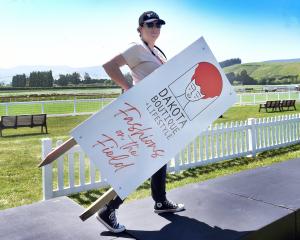Erika Wolf, from New York, shows how to stuff, dress and roast a turkey for Thanksgiving.
Erika Wolf came to Dunedin in 2003 to lecture at the University of Otago, but she says she has been cooking Thanksgiving meals around the planet for a decade, including in Romania where she couldn't get a turkey so made a chicken mole instead.
Thanksgiving is a North American holiday, a harvest festival celebrated on the fourth Thursday in November in the US and the second Monday in October in Canada. Because it is neither religious nor ethnic, it is celebrated by all Americans - although Native Americans may have a different view. It is a family time and has not been commercialised, unlike Christmas, she said.
The first Thanksgiving took place after a Native American tribe intervened to assist struggling English settlers in Plymouth, Massachusetts. The initial feast was largely provided by the Wampanoag tribe and marked a land treaty with the English that would be rapidly broken and bring death and suffering to the local Native Americans, she said.
Thanksgiving food uses ingredients indigenous to the Americas - turkey, cranberries, mashed potato, glazed sweet potato, pumpkin (as pie), and often corn, wild rice, and other dishes.
In the southern hemisphere, Thanksgiving falls in spring instead of autumn but it's still usually possible to find pumpkin, carrots and celery, she says.
• Thanks to Afife Harris and Crozier's Free Range Turkeys.
1 turkey, thawed or fresh with giblets (allow about kg per person)
2 stalks celery, chopped in large pieces
1 onion, sliced roughly
1 carrot, peeled and quartered
¼ cup plain flour
chicken stock
salt and pepper
port or red wine (optional)
Preheat oven to 160degC.
Prepare stuffing (see below). The stuffing may be made the night before, but do not stuff the turkey until just before roasting for food-safety reasons.
Remove the neck and giblets from the cavity. Place in a roasting pan with the vegetables. The turkey will sit on these to roast and they will provide extra flavour for the gravy.
Stuff the neck and main cavities of the turkey with the stuffing, pushing in as much as you can. Tuck the neck flap down to keep the stuffing in the cavity, and push the legs under a flap of skin or tie them together to keep them in place so the stuffing doesn't fall out.
Place the turkey on the bed of vegetables and add three cups of water to the pan. Dot the breast with butter.
You can roast the turkey breast-down which prevents the breast drying out while the rest of the bird cooks, but you do not get the lovely crisp, golden brown skin.
As the turkey cooks, baste the breast with the juices from the pan from time to time. If the breast is getting too brown, cover with tinfoil.
Cook for the time recommended on the turkey packaging or, if the turkey has a pop-up indicator, until it pops up.
To test if the turkey is done, poke a knife under the drumstick. If the juices run clear it is done. The flesh around the drumstick will also be loose.
When the turkey is done, take it from the pan and leave it on a cutting board in a warm place to rest.
Strain the juices from the pan. American turkeys have lots of fat which needs to be skimmed off, but the free-range turkey has little fat.
Make the juices up to four cups with chicken stock, and put in a saucepan to heat. Whisk in cup flour and bring to boil, continuing to whisk so lumps don't form. Season to taste and add wine or port if desired.
Carve the bird and serve with stuffing and fresh cranberry relish.
Stuffing should be a surprise and a pleasure so Erika likes to put lots of goodies in it.
Many people like the stuffing by itself so prepare plenty. What doesn't fit in the bird can be baked separately with a little butter dotted on top, and eaten as a side dish or by itself later.
• Stuffing
Enough for a 8-9kg bird
2 Tbsp vegetable oil
3 cups chopped celery, with leaves
2 cups chopped onion
500g fresh pork sausage
2 Granny Smith apples chopped, with skin on
1 cup skinned, toasted hazelnuts, slightly chopped
1 cup dried cranberries or dried cherries
6 cups stale bread, cubed (from a good, firm bread, a mix of white and wholemeal or rye)
1 tsp salt
1 tsp dried thyme or 3 tsp fresh, chopped thyme
1 tsp dried sage or 3 tsp chopped fresh sage
freshly ground black pepper
1 cup tawny port
1 cup chicken stock
Saute the celery and onion in the oil then place in a large mixing bowl. Cook the sausages thoroughly, and when cool enough to handle, chop into smaller pieces and add to bowl.
Add nuts, fruit, bread cubes and seasoning and stir together.
Sprinkle in the liquid and mix to blend all ingredients.
Erika Wolf prefers the fresh flavours of this to bought cranberry sauce. It's difficult to find fresh cranberries here so she uses frozen ones. This relish is best made the day before to allow the flavours to meld. It can be used as a sauce for many foods, and is good with barbecues. It will keep for a week or more in the fridge.
• Fresh cranberry relish
1 bag (375g) frozen cranberries
1 orange, peel and all, roughly chopped (remove pips)
1 cup sugar
¼ cup Grand Marnier or other orange liqueur (optional)
Place cranberries, orange pieces and sugar in a processor and chop until evenly minced. Stir in liqueur and allow to sit overnight.












